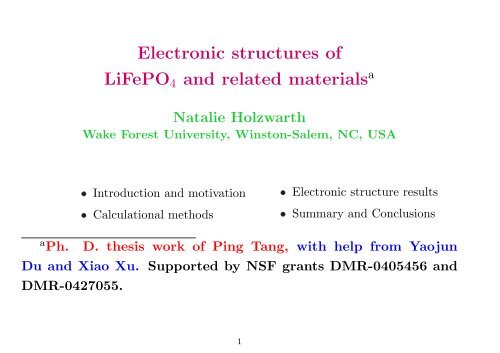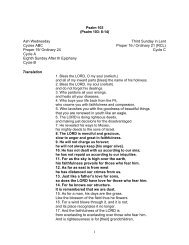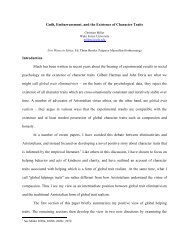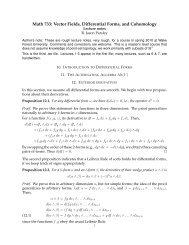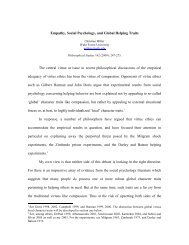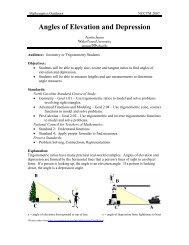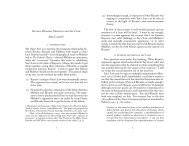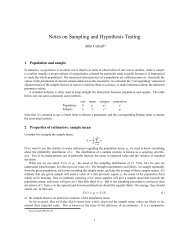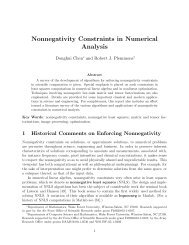Electronic structures of LiFePO4 and related materials - Wake Forest ...
Electronic structures of LiFePO4 and related materials - Wake Forest ...
Electronic structures of LiFePO4 and related materials - Wake Forest ...
You also want an ePaper? Increase the reach of your titles
YUMPU automatically turns print PDFs into web optimized ePapers that Google loves.
<strong>Electronic</strong> <strong>structures</strong> <strong>of</strong>LiFePO 4 <strong>and</strong> <strong>related</strong> <strong>materials</strong> aNatalie Holzwarth<strong>Wake</strong> <strong>Forest</strong> University, Winston-Salem, NC, USA• Introduction <strong>and</strong> motivation• Calculational methods• <strong>Electronic</strong> structure results• Summary <strong>and</strong> Conclusionsa Ph. D. thesis work <strong>of</strong> Ping Tang, with help from YaojunDu <strong>and</strong> Xiao Xu. Supported by NSF grants DMR-0405456 <strong>and</strong>DMR-0427055.1
Performance comparison <strong>of</strong> different rechargeable AA-size (or equivalent)batteries at 20 o C. (Figure from Interface 15:1, 18 (2006).)2
Diagram <strong>of</strong> discharge operation for a Li-ionbatteryLi +− +Cathode Electrolyte Anodee −V = IRI3
CathodesLiCoO 2LiMn 2 O 4LiFePO 4Some battery <strong>materials</strong>ElectrolytesLiPF 6 (liquid)PEO & other polymersLiPON ( Li 3 PO 4 glass)AnodesLi metalLiAl alloyLiC 64
J. Electrochem. Soc. 144 1188, (1997)5
Accumulated number <strong>of</strong> papers on LiFePO 4(Estimated from the number <strong>of</strong> citations <strong>of</strong> the original articles:“Phospho-olivines as positive-electrode <strong>materials</strong> for rechargeable lithium batteries”, A. K.Padhi, K. S. Nanjundaswamy, <strong>and</strong> J. B. Goodenough, JECS 144 1188, (1997); “Effect <strong>of</strong>structure on the Fe 3+ /Fe 2+ redox couple in iron phosphates”, A. K. Padhi, K. S.Nanjundaswamy, C. Masquelier, S. Okada, <strong>and</strong> J. B. Goodenough, JECS 144 1609, (1997)400Accumulated citations300200100019982000year2002200420066
Commercial use <strong>of</strong> LiFePO 4 ???(pure speculation)In 2001, Pr<strong>of</strong>essor Yet-Ming Chiang, Department <strong>of</strong> Materials Science <strong>and</strong>Engineering, M. I. T. co-founded A123Systems, a startup company involved withdeveloping, manufacturing, <strong>and</strong> marketing batteries based on lithium metalphosphate. (http://www.a123systems.com)Watertown, Mass. November 2,2005:A123Systems, developer <strong>of</strong> a new generation<strong>of</strong> Lithium-ion batteries, today unveiledits technology <strong>and</strong> announced thatit is delivering batteries with unprecedentedpower, safety, <strong>and</strong> life as comparedto conventional Lithium technology.A123Systems first battery is now in production<strong>and</strong> being delivered to the Black& Decker Corporation (NYSE: BDK). Itwill be first utilized by the corporation’sDEWALT br<strong>and</strong>, a leading manufacturer<strong>of</strong> power tools.7
What can computer simulations do to advanceour underst<strong>and</strong>ing <strong>of</strong> LiFePO 4 <strong>materials</strong>?The role <strong>of</strong> computation in electrochemical research is not as prominent as it isin the semiconductor <strong>and</strong> catalysis fields. Our work was inspired by a talk givenby Pr<strong>of</strong>essor Gerbr<strong>and</strong> Ceder <strong>of</strong> M. I. T. given at the Fourteenth AnnualWorkshop on Recent Developments in <strong>Electronic</strong> Structure Methods – ES2002 inwhich he summarized his pioneering work on the cathode <strong>materials</strong> LiCoO 2 ,LiNiO 2 , <strong>and</strong> LiMn 2 O 4 . (More recently, Ceder <strong>and</strong> his group have made majoradvances in the underst<strong>and</strong>ing <strong>of</strong> the LiFePO 4 family as well.)Outline <strong>of</strong> our work• Introduction to the general features <strong>of</strong> the electronic <strong>structures</strong> <strong>of</strong> theelectrochemically active forms <strong>of</strong> LiFePO 4 <strong>and</strong> FePO 4 .• Comparison <strong>of</strong> the electrochemically active form <strong>of</strong> FePO 4 with 3 othermeta-stable crystalline <strong>structures</strong>.• Beginning work on Li-ion diffusion mechanisms in Li 3 PO 4 .8
Calculational methodsMethodPAWpwpaw - pwpaw.wfu.edusocorro - dft.s<strong>and</strong>ia.gov/socorroabinit - www.abinit.orgLAPWwien2k - www.wien2k.atPWscfpwscf - www.pwscf.orgCommentsWorks well for moderately large unit cells,but variable unit cell optimization not yet implementedin pwpaw <strong>and</strong> socorro. Need toconstruct <strong>and</strong> test PAW basis <strong>and</strong> projectorfunctions.Works well for smaller unit cells; variable unitcell optimization not implemented. Need tochoose non-overlapping muffin tin radii <strong>and</strong>avoid “ghost” solutions.Works well for large unit cells <strong>and</strong> includesvariable unit cell optimization. Need to construct<strong>and</strong> test s<strong>of</strong>t pseudopotential functions.9
Secret recipe <strong>of</strong> calculational parametersr c (bohr)Atomic basisFePAW ∗ 1.90 3s, 4s, 3p, 4p, 3d, ɛdPWscf † 1.90 3s, 4s, 3p, 4p, 3d, ɛdLAPW 1.95 3s, ɛs, 3p, ɛp, ɛdOPAW ∗ 1.41 2s, ɛs, 2p, ɛpPWscf † 1.40 2s, ɛs, 2p, ɛpLAPW 1.28 2s, ɛs, ɛpPPAW ∗ 1.51 2s, 3s, 2p, 3pPWscf † 1.50 3s, ɛs, 3p, ɛp, ɛdLAPW 1.38 ɛs, 2p, ɛp∗ PAW basis <strong>and</strong> projector functions generated by atompaw code.† Ultra-s<strong>of</strong>t pseudopotentials generated by uspp code <strong>of</strong> David V<strong>and</strong>erbilt.10
Details on constructing the PAW basis <strong>and</strong> projector functionsFor each all-electron basis function φ i (r), we need to construct corresponding pseudo-basisfunctions ˜φ i (r) <strong>and</strong> projector functions ˜p i (r). Two slightly different variations:• Blöchl’s scheme (PR B 50, 17953 (1994)): choose shape <strong>of</strong> ˜p i (r) <strong>and</strong> derive ˜φ i (r).• V<strong>and</strong>erbilt’s scheme (PR B 41, 7892 (1990)): choose shape <strong>of</strong> ˜φ i (r) <strong>and</strong> derive ˜p i (r).Example for 3d functions <strong>of</strong> Fe:30.152.52p(r)~Bloechl schemeV<strong>and</strong>erbilt scheme0.1Bloechl schemeV<strong>and</strong>erbilt scheme1.5F(q)1φ(r)0.050.5~φ(r)00 0.5 1r (bohr)1.5 200 2 4 6q (bohr) -1Basis <strong>and</strong> projector functions F (q) ≡ ¯˜p(q)¯˜φ(q)q211
Other computational details• Spin polarized calculations performed assuming full crystal symmetry(“ferromagnetic” spin configuration).• Exchange-correlation functionals –LDA: J. Perdew <strong>and</strong> Y. Wang, Phys. Rev. B 45, 13244 (1992)GGA: J. Perdew, K. Burke, <strong>and</strong> M. Ernzerh<strong>of</strong>, PRL 77, 3865 (1996)12
Test results for simple oxides∆E (eV)0.50.40.3GGAPWscfPAWLAPWLi 2OLDAPWscfPAWLAPW∆E (eV)0.50.40.3FeOGGAPWscfPAWLAPWLDAPWscfPAWLAPW∆E (eV)1.210.80.6GGAPWscfPAWLAPWPO 4LDAPWscfPAWLAPW0.20.20.40.10.10.208 8.5 9 9.5a (bohr)07.5 7.75 8 8.25 8.5 8.75a (bohr)02.8 2.9 3 3.1b (bohr)Fluorite structure NaCl structure Tetrahedral moleculeNote: This kind <strong>of</strong> consistency is generally not possible withparameters taken “<strong>of</strong>f the shelf”.13
Introduction to general features <strong>of</strong> the electronic<strong>structures</strong> <strong>of</strong> the electrochemically active forms <strong>of</strong>LiFePO 4 <strong>and</strong> FePO 4Ref: “<strong>Electronic</strong> <strong>structures</strong> <strong>of</strong> FePO4, <strong>LiFePO4</strong>, <strong>and</strong> <strong>related</strong> <strong>materials</strong>”, Ping Tang<strong>and</strong> N. A. W. Holzwarth, Phys. Rev. B 68, 165107 (2003)14
FePO 4 <strong>and</strong> LiFePO 4in olivine (Pnma) structureFePO 4 LiFePO 415
LSDA partial densities <strong>of</strong> states for olivine <strong>materials</strong>42FePO 4N(E) (states/(eV. spin . sphere))02442024LiFePO 4LiFePO-10 -5 0 5 10E (eV)16
Partial densities for majority spin FePO 4states4 I II III FeP2O0-10 -5 0 5E (eV)I: −9.9 ≤ E ≤ −6.2 eV II: −6.2 ≤ E ≤ −2.3 eV III: −2.3 ≤ E ≤ −0.1 eV17
Partial densities for majority spin LiFePO 4states4 I II III LiFe2PO0-10 -5 0 5E (eV)I: −11.1 ≤ E ≤ −7.7 eV II: −7.7 ≤ E ≤ −3.4 eV III: −3.3 ≤ E ≤ −1.2 eV18
Summary <strong>of</strong> results for FePO 4 <strong>and</strong> LiFePO 4FePO 4 – Fe +3 ⇐⇒ Fe 3d 5 ↑ ; strong hybridization <strong>of</strong> Fe 3d ↑ <strong>and</strong> O2p ↑ b<strong>and</strong>sLiFePO 4 – Fe +2 ⇐⇒ Fe 3d 5 ↑ d1 ↓; Fe 3d states form narrow b<strong>and</strong>swith very little O 2p character19
Comparison <strong>of</strong> the electrochemically active form<strong>of</strong> FePO 4 with 3 other crystalline <strong>structures</strong>Summary <strong>of</strong> experimental situation:• FePO 4 in its “olivine” structure is the delithiated product <strong>of</strong> LiFePO 4 ,known as a promising cathode material for rechargeable Li ion batteries.(Padhi,Nanjundaswamy, Goodenough, J. Electrochem. Soc. 144, 1188(1997))• Yang, Song, Zavalij, <strong>and</strong> Whittingham (Electrochem. Comm. 4, 239 (2002))showed that olivine FePO 4 irreversibly transforms to a quartz-like structureat ≈ 600 o C.• Song, Zavalij, Suzuki, <strong>and</strong> Whittingham (Inorg. Chem. 41, 5778 (2002))investigated the structural <strong>and</strong> electrochemical properties <strong>of</strong> severalcrystalline forms <strong>of</strong> FePO 4 .• Iyer, Delacourt, Masquelier, Tarascon, <strong>and</strong> Navrotsky (Electrochem.Solid-State Lett. 9, A46 (2006)) showed that that the olivine structure ismore stable than the quartz structure.20
Computational challenge1. Can we reliably predict the most stable structure?2. If so:(a) Can we underst<strong>and</strong> what factors control thestructural stability?(b) Can we underst<strong>and</strong> what factors control theelectrochemical activity? can we underst<strong>and</strong>what determines its structural stability?21
Crystal <strong>structures</strong>“Olivine”Space group: PnmaMineral names: olivine, heterositeProperties: Li ion cathode (LiFePO 4 )“Quartz”Space group: P3 1 21Mineral names: α-quartz, berliniteProperties: Catalyst, electrochemically inactiveForms at 600 o C from olivine phase22
Crystal <strong>structures</strong> – continued“CrVO 4 -type”Space group: CmcmSynthesized at high pressure from quartz formProperties: Electrochemically inactiveArroyo-de Dompablo, Gallardo-Amores, Amador,Electrochem. Solid-State Lett. 8, A564 (2005)“Monoclinic”Space group: P2 1 /nSynthesized by dehydrating phosphosideriteProperties: Partial electrochemical activitySong, Zavalij, Suzuki, Whittingham,Inorg. Chem. 41, 5778, 200223
Crystal volumes – optimized <strong>and</strong> experimental(in units <strong>of</strong> Å 3 /FePO 4 )Crystal LDA GGA ExpOlivine 67.9(LAPW) 67.5 74.5(PAW) 74.5(PWscf) 68.1 74.0Quartz 82.4(LAPW) 79.9 91.9(PAW) 91.9(PWscf) 79.8 91.3CrVO 4 -type 64.2(LAPW) 62.3(PWscf) 62.8 68.6Monoclinic 82.1(LAPW) 81.3 91.4(PWscf) 81.9 88.424
Internal Energy Differences(in units <strong>of</strong> eV/FePO 4 )Crystal LDA GGA ExpOlivine 0.00 0.00 0.00Quartz0.12 ∗(LAPW) 0.09 −0.35(PAW) 0.05 −0.27(PWscf) 0.09 −0.25CrVO 4 -type(LAPW) −0.10(PAW) −0.11 0.07(PWscf) −0.07 0.07Monoclinic(LAPW) 0.02 −0.19(PAW) −0.01 −0.16(PWscf) −0.02 −0.17∗ Iyer, Delacourt, Masquelier, Tarascon, <strong>and</strong> Navrotsky,Electrochemical <strong>and</strong> Solid-State Letters 9, A46 (2006).25
LDSA partial densities <strong>of</strong> states for FePO 44Olivine4Monoclinic22N(E) (states/(eV . spin . sphere))002244Quartz44CrVO 4FePO22002244-8 -6 -4 -2 0 2 4 6 8E (eV)-8 -6 -4 -2 0 2 4 6 8E (eV)26
LSDA b<strong>and</strong> gaps <strong>and</strong> widths for FePO 4 crystals(B<strong>and</strong> widths refer to Fe 3d majority spin states)Crystal B<strong>and</strong> gap (eV) B<strong>and</strong> width (eV)Olivine 0.1 8.1Quartz 0.8 5.2CrVO 4 -type 0.0 8.9Monoclinic 0.4 6.027
Results so far for FePO 41. Can we reliably predict the most stable structure? no2. If not, what is missing from our simulations?(a) We suspect the electron self-interaction error to be the mostimportant contribution, especially for the very localized Fe 3dstates.(b) Possibly, electron correlation effects could also be significant.28
Li-ion diffusion mechanisms in electrolyte material Li 3 PO 4LiFePO 4 γ-Li 3 PO 4(cathode)(electrolyte)29
Li + diffusion by possible interstitial mechanism in γ- Li 3 PO 4Relaxed <strong>structures</strong> about two meta-stable interstitial sites. (Arrows indicatemagnitude <strong>and</strong> direction <strong>of</strong> distortion relative to perfect crystal. Darker greenball indicates interstitial position.)Site 1 Site 230
Li + diffusion by possible vacancy mechanism in γ- Li 3 PO 4Relaxed <strong>structures</strong> about two meta-stable vacancy sites. (Arrows indicatemagnitude <strong>and</strong> direction <strong>of</strong> distortion relative to perfect crystal, scaled by 2×relative to interstitial case. Light green ball indicates vacancy position.)Site 1 Site 231
Results so far for Li-ion diffusion mechanisms in γ-Li 3 PO 4• Found several meta-stable interstitial <strong>and</strong> vacancy configurations.• Currently investigating the barriers for diffusion between thesesites along several likely paths.32
Summary• With careful attention to calculational details, we are able to obtain nearlyidentical results using independent s<strong>of</strong>tware packages.• Investigated general features <strong>of</strong> the electronic <strong>structures</strong> <strong>of</strong> theelectrochemically active forms <strong>of</strong> LiFePO 4 <strong>and</strong> FePO 4 .• Compared <strong>of</strong> the electrochemically active form <strong>of</strong> FePO 4 with 3 othermeta-stable crystalline <strong>structures</strong>. Need to estimate electron self-interactionerror.• Currently studying Li-ion diffusion mechanisms in the electrolyte materialLi 3 PO 4 .33
Collaborators:Ph. D. Thesis: Ping TangPostdoc: Yaojun DuAcknowledgmentsBeginning Grad. Student: Xiao XuFunding:• NSF DMR-0405456• NSF DMR-0427055Graphics s<strong>of</strong>tware:• XCrySDen (http://www.xcrysden.org), written by Anton Kokalj• dx (http://www.opendx.org) (based on Data Explorer, a general purposevisualization package originally developed at IBM.)34


